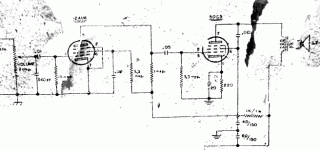It's not "number of stages", we aren't buying tires.
Pentode needs a screen network and the cap required can be large (expensive).
Pentode makes gain of 50-200. Triode makes gain of 50. But two triodes makes gain over 2,000. Cascading the simpler/cheaper stages is great leverage.
Does a Champ need a whole 12AX7? Clearly no. The first 12AX7 Champs ran unbypassed cathode resistors to reduce gain (and cost!). The AA Champ adds in a lossy tonestack and NFB around the output, and has just-enough gain. (Note that the MID resistor is increased from its value in the bigger amps to reduce tonestack loss; also so the Champ retains a little "nasal" which can be nulled in the $$$ amps.)
The one-pentode plan never went away. My cardboard Kent is such. I think aside from not having a LOT of gain, it has a problem that hot hard strumming will overload the pentode before it gets to the Volume control. My assumption is that, at 300V supply, gain of 50 is about all you can stand in the first pre-Vol stage without rude sounds that can't be dialed-away. (And the Kent's supply is only 90V.....) EDIT: the Kent won't overload, the Vol is before the pentode; instead it hisses at any Vol setting.)
System Analysis suggests that you want gain before volume for good S/N, and the usual Power tubes need gain between them and the volume control so the pre-Vol stage does not go into overload. Gain, Vol, gain, power-stage. Two little gain stages. Any less, something is going to suffer.
Pentode needs a screen network and the cap required can be large (expensive).
Pentode makes gain of 50-200. Triode makes gain of 50. But two triodes makes gain over 2,000. Cascading the simpler/cheaper stages is great leverage.
Does a Champ need a whole 12AX7? Clearly no. The first 12AX7 Champs ran unbypassed cathode resistors to reduce gain (and cost!). The AA Champ adds in a lossy tonestack and NFB around the output, and has just-enough gain. (Note that the MID resistor is increased from its value in the bigger amps to reduce tonestack loss; also so the Champ retains a little "nasal" which can be nulled in the $$$ amps.)
The one-pentode plan never went away. My cardboard Kent is such. I think aside from not having a LOT of gain, it has a problem that hot hard strumming will overload the pentode before it gets to the Volume control. My assumption is that, at 300V supply, gain of 50 is about all you can stand in the first pre-Vol stage without rude sounds that can't be dialed-away. (And the Kent's supply is only 90V.....) EDIT: the Kent won't overload, the Vol is before the pentode; instead it hisses at any Vol setting.)
System Analysis suggests that you want gain before volume for good S/N, and the usual Power tubes need gain between them and the volume control so the pre-Vol stage does not go into overload. Gain, Vol, gain, power-stage. Two little gain stages. Any less, something is going to suffer.
Attachments
Last edited:
In my limited experience with small signal pentodes, they tend to overload even though I designed the gain stage for rather low gain, as close as I could get to that of a typical half-12AX7. In practice, that meant voltage gain around 65 - 70 times....hot hard strumming will overload the pentode before it gets to the Volume control. My assumption is that, at 300V supply, gain of 50 is about all you can stand...
I think the overloading was often happening at the input, at the control grid, because it was hard to get Vgk as negative as (-1.5 volts) at reasonable screen voltages without outright cutting off the pentode (because of relatively high gm.)
Some of my humbucker-equipped guitars seem to be able to overload the control grid of a half-12AX7 biased to Vgk=(-1.5V), so they had no trouble overloading a control grid only biased to (-1.0 V) or so.
The clip Printer2 posted is interesting - no audible signs of pentode clipping at all, and only relatively small amounts of audible harmonic distortion.
-Gnobuddy
- Status
- Not open for further replies.
